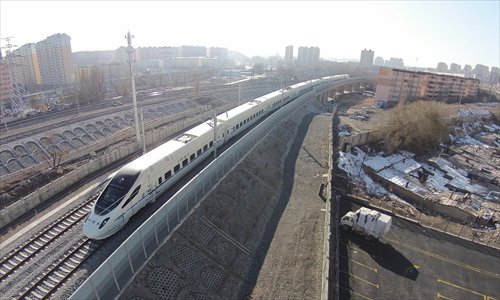HOME >> CHINA
Not-so-far West
Source:Xinhua-Global Times Published: 2014-12-7 19:48:01
High-speed rail bringing western China closer than ever

The first train runs on the Lanxin High-speed railway on November 16. Photo:CFP

Passengers talk with a stewardess during their journey November 16. Photo:CFP
To Alimjian (pseudonym), going back home is no longer a bumpy and time-consuming ordeal.
Seven years ago, a trip to school in Beijing from his hometown in Urumqi, capital city of Northwest China's Xinjiang Uyghur Autonomous Region took more than 70 hours. Four years ago, after the young man graduated from high school, that number dropped to a little over 40 hours.
"You part with friends more and more quickly on the train [now], but it is one of the best things to feel the smell of your hometown," Alimjian told the Global Times. The 21-year-old university senior will soon be able to go back home within a single day in 2017 when a high-speed railway between Urumqi and Beijing connects the two cities in a mere 16 hours.
Alimjian is already excited about the timetable for high-speed rail development in his hometown.
On November 16, the first high-speed rail in Alimjian's hometown was put into operation, traveling from Urumqi to Hami. By the end of this year it will extend to Lanzhou, capital city of Gansu Province.
"Xinjiang will be no longer an isolated region in the far west of China. Distance will finally not be a problem," said Alimjian.
Fast access to the Silk Road
The 1,776-kilometer Lanzhou-Xinjiang high-speed rail line, also known as the Lanxin high-speed rail, will pass through China's northwestern regions of Gansu, Qinghai and Xinjiang, making it the first high-speed railway built in a high-altitude region in China.
According to data from Xinjiang's development and reform commission, the new rail line will increase annual freight volumes to 150 million tons, compared with 78.5 million tons in 2013.
For years, the Lanxin railway was the only link between Xinjiang and other parts of China.
Li Hanlin, director of the socio-economic development institution of Party School of the Communist Party of China Gansu Provincial Committee, said the Lanxin high-speed railway will upgrade northwestern China's railway network, enhance transportation capacities and promote the development of the Silk Road Economic Belt.
"More oil, coal and new energy bases are expected to be built along the new rail line," said Sun Faping, a research fellow with the Academy of Social Sciences of Qinghai Province. "This will help better allocate energy sources from the country's vast western region and [should bring down] prices for industrial raw materials."
Tourism will also benefit from the new high-speed rail. Scenic spots in the nation's far west are abundant, but scattered. Travelers used to spend most of their time on the road, moving between sites. The new high-speed rail will change the current situation, said Zhu Ming, director of the tourist bureau of Jiayuguan in Gansu. "Touring along the Silk Road will become more convenient."
One-hour economic circle
The nation's expanding high-speed railway projects also reduce the travel time between cities within the same region, paving the path for regional economic development.
A total of 18 world renowned enterprises, including German car giant Volkswagen, have decided to set up factories in a new economic development zone in Urumqi. The development zone has to date attracted over 35 billion yuan($5.69 billion) of total investment, with the potential to create as many as 230,000 jobs, reported the Xinhua News Agency.
High-speed rail will shorten the trip from Urumqi to Turpan to about 40 minutes.
"Population distribution is an important factor in regional economic development. Boosting high-speed railways and intercity transportation will be good for cities' overall development," said Yu Guangjun, director of the Institute of Economics of the Inner Mongolia Academy of Social Sciences.
Linked with the world
With construction of the high-speed railway expanding to the west, more remote areas are becoming increasingly connected with the outside world.
The 857-kilometer Guiyang-Guangzhou railway express line, to be put into service soon, links capital city of Guizhou Province with Guangzhou, capital of South China's Guangdong Province, one of the country's economic powerhouses. The high-speed rail line will shorten the travel time between the two cities from 20 hours to four.
The Guiyang-Guangzhou express line will also help businesses in the southwest part of the country expand into the Pearl River Delta. "We're planning to build an exhibition hall for local herbal medicine in Longli county in Guizhou after the high-speed rail comes online, to attract buyers from the Pearl River Delta," said Li Qiang, manager of a Chinese herbal medicine technology company in Guizhou.
Longli is home to more than 20 ethnic minorities, and used to be little known to the outside world. The county will be only 10 minutes away from Guiyang, after the operation the Guiyang-Guangzhou high-speed rail comes online. Over the past two years, the county has already drawn 70 companies into a new high-tech park. Its GDP for 2014 is expected to reach 5 billion yuan.
"I hope that my dream will come true soon, when I could have morning tea in the metropolitan Guangzhou, lunch in the neighboring region's scenic Guilin and dinner back in Guiyang," said Chen Ruyi, a 71-year-old citizen in Guiding county, a neighboring county of Longli.
Posted in: Society